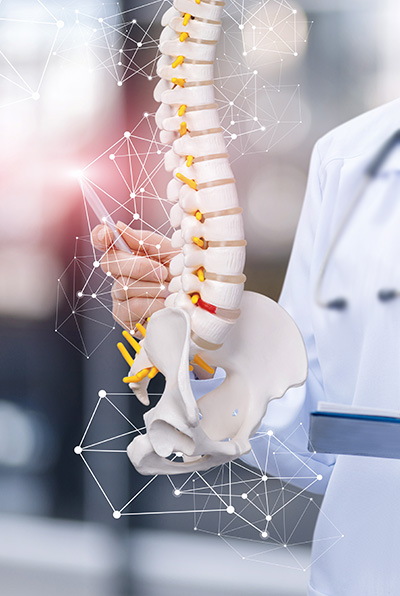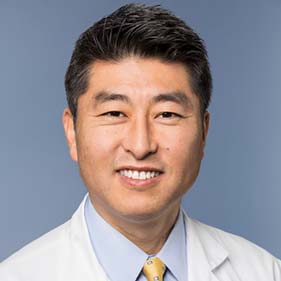Clinical trial offers hope for patients with severe spinal cord injuries
Study shows improvements with the use of neuro-spinal scaffold
Jason Cervantes of Chico had a freak accident nearly two years ago.
In March 2021, the then-16-year-old was working on the engine of his vintage truck in his driveway and pulled the driveline. He’d forgotten to secure the vehicle with tire blocks. Suddenly, the truck began to move and rolled forward into Cervantes, crushing him beneath it.
He was rushed to a local hospital, where doctors quickly realized his spinal injuries were severe and needed specialty care. They ordered a helicopter to take him to UC Davis Medical Center, where he underwent surgery the following morning.

The accident left Cervantes paralyzed from the waist down. He now gets around using a wheelchair.
Always a go-getter, Cervantes wanted a way to help others like himself with spinal cord injuries. So, he agreed to participate when UC Davis Health surgeons approached him about a nationwide clinical trial testing a new treatment to regenerate the spinal cord.
Kee Kim, chief of spinal neurosurgery and co-director of the UC Davis Spine Center, is leading the randomized study.
The treatment includes the placement of an absorbable biopolymer scaffold at the site of a spinal injury. Researchers hope it will lead to improvement in spinal cord function. Spinal neurosurgeon Allan Martin operated on Cervantes as part of the trial.
Cervantes, now in the second year of the trial, doesn’t know if he received the treatment – or if he’s in the control group, which doesn't receive the scaffold.
"This may not help me if I'm not chosen [for the treatment]," Cervantes explained, "but if by participating in this research I can help others with a similar injury later, then it's worth it."
Spinal cord injuries and ongoing research
About 12,500 new spinal cord injuries occur annually in the United States. Roughly 40 percent are classified as severe.
Severe injuries, such as the one Cervantes received, happen when there is physical damage to the spinal cord. Typically, the injury will disrupt nerve transmission in the spinal cord, and soon after injury, the spinal cord will swell at the site of damage. The swelling increases pressure on the spinal cord and may even cut blood flow to the surviving nerves.
This may impact a person's sensory functions and motor skills and even lead to full or partial paralysis of the organs and limbs of the body. A cyst (a sac-like pocket of filmy tissue that contains fluid, air or other substances) may also form on the spinal cord at the site of injury — further obstructing spinal cord regeneration.
UC Davis Health has the most active spinal cord injury clinical trial program in California, if not in the nation. Our work wouldn't be possible without the dedicated team of residents, fellows, advanced practice providers, clinical research coordinators, and spine colleagues. We work together to make significant contributions to improve the lives of our injured and paralyzed patients. It wouldn't be possible without our team effort." —Kee Kim
A neuro-spinal scaffold offers hope.
The clinical trial conducted at medical centers around the country offers some hope. It is a follow-up to successful animal trials.
The trial recruited 16 people ages 16-70 with severe injuries in the thoracic section of their spinal column.
The thoracic section begins at the neck's base, extends to the bottom of the rib cage, and includes 12 vertebrae (known as T1-T12). The innovative treatment involves placing an investigational neuro-spinal scaffold (by InVivo Therapeutics Corp.) into the injured spinal cord. This highly porous biopolymer device is broken down and absorbed by the body.

In early 2021, Kim and his team released the initial study results in the Journal of Neurosurgery Spine. The journal recognized this paper as one of the six best spine papers published last year.
Researchers shared the six-month outcome of the 16 study participants. They found that patients treated with the device reported regaining some feeling in the paralyzed areas of their body at a slightly higher rate than patients with a similar injury who did not receive the intervention.
Earlier this year, the team published a 24-month follow-up in Neurosurgery. They reported that some of the patients with the device improved even further. The investigators did not witness any unanticipated or severe complications.
“These results suggest that we may be on the path to eventual treatments that may significantly improve quality of life for patients with spinal cord injuries, perhaps even allowing them to function without a wheelchair,” Kim said.
He added that this is believed to be the first study that establishes it is safe to place a neural-spinal scaffold device into an injured spinal cord.
UC Davis home to exceptional spinal cord injury team
The early success of this study is providing hope to injured patients and their families.
"UC Davis Health has the most active spinal cord injury clinical trial program in California, if not in the nation," said Kim. "Our work wouldn't be possible without the dedicated team of residents, fellows, advanced practice providers, clinical research coordinators, and spine colleagues. We work together to make significant contributions to improve the lives of our injured and paralyzed patients, and it wouldn't be possible without our team effort."
Cervantes' mother is grateful her son can be part of such an important clinical trial. She has leaned on her faith to get through her son's difficult journey.
“It’s all up to God for things to happen,” she said. “But God also gives us these doctors and these research projects to improve medicine and the quality of people’s lives. Being a part of this helps these doctors figure out what will eventually help other people.”




